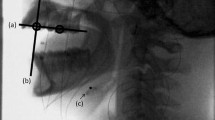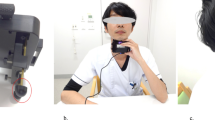Abstract
The purpose of this study was to investigate the effect of bolus consistency and sex on the activity of the submandibular hyolaryngeal muscles during swallowing. Twenty young, healthy adults (10 males, 10 females) swallowed four types of bolus material (thin liquid, thick liquid, pudding, and cookie) while being measured with surface electromyography. Measurements of peak contraction amplitude and contraction duration were computed from recorded electromyographic signals. Results from statistical analyses revealed a significant effect of bolus consistency on measures of peak contraction amplitude, but not contraction duration. There were no significant effects of sex on either measure. Findings from this study further the body of knowledge in electrophysiological measurements acquired during swallowing and their potential clinical application during assessment and treatment of dysphagia.



Similar content being viewed by others
References
Logemann JA. Evaluation and treatment of swallowing disorders. 2nd ed. Austin: Pro Ed; 1998.
Inamoto Y, Saitoh E, Okada S, et al. The effect of bolus viscosity on laryngeal closure in swallowing: kinematic analysis using 320-row area detector CT. Dysphagia. 2013;28(1):33–42. doi:10.1007/s00455-012-9410-4.
Van den Engel-Hoek L, de Groot IJM, Esser E, et al. Biomechanical events of swallowing are determined more by bolus consistency than by age or gender. Physiol Behav. 2012;106(2):285–90. doi:10.1016/j.physbeh.2012.02.018.
Ruark JL, McCullough GH, Peters RL, Moore C. Bolus consistency and swallowing in children and adults. Dysphagia. 2002;17(1):24–33. doi:10.1007/s00455-001-0098-0.
Stokely SL, Molfenter SM, Steele CM. Effects of barium concentration on oropharyngeal swallow timing measures. Dysphagia. 2014;29(1):78–82. doi:10.1007/s00455-013-9485-6.
Molfenter SM, Steele CM. Variation in temporal measures of swallowing: sex and volume effects. Dysphagia. 2013;28(2):226–33. doi:10.1007/s00455-012-9437-6.
Im I, Kim Y, Ph D, et al. The effects of bolus consistency in pharyngeal transit duration during normal swallowing. Ann Rehabil Med. 2012;36:220–5.
Molfenter SM, Steele CM. Temporal variability in the deglutition literature. Dysphagia. 2012;27(2):162–77. doi:10.1007/s00455-012-9397-x.
Crary MA, Carnaby Mann GD, Groher ME, Helseth E. Functional benefits of dysphagia therapy using adjunctive sEMG biofeedback. Dysphagia. 2004;19(3):160–4. doi:10.1007/s00455-004-0003-8.
Crary MA, Carnaby Mann GD, Groher ME. Identification of swallowing events from sEMG signals obtained from healthy adults. Dysphagia. 2007;22(2):94–9. doi:10.1007/s00455-006-9059-y.
Yoshida M, Groher ME, Crary MA, Mann GC, Akagawa Y. Comparison of surface electromyographic (sEMG) activity of submental muscles between the head lift and tongue press exercises as a therapeutic exercise for pharyngeal dysphagia. Gerodontology. 2007;24(2):111–6.
Vaiman M, Eviatar E. Surface electromyography as a screening method for evaluation of dysphagia and odynophagia. Head Face Med. 2009;5:9. doi:10.1186/1746-160X-5-9.
Palmer PM, Luschei ES, Jaffe D, McCulloch TM. Contributions of individual muscles to the submental surface electromyogram during swallowing. J Speech, Lang Hear Res. 1999;42:1378–91.
Crary MA, Mann GDC, Groher ME. Biomechanical correlates of surface electromyography signals obtained during swallowing by healthy adults. J Speech, Lang Hear Res. 2006;49(1):186–93.
Watts CR. Measurement of hyolaryngeal muscle activation using surface electromyography for comparison of two rehabilitative dysphagia exercises. Arch Phys Med Rehabil. 2013;94(12):2542–8. doi:10.1016/j.apmr.2013.04.013.
Inagaki D, Miyaoka Y, Ashida I, Yamada Y. Activity pattern of swallowing-related muscles, food properties and body position in normal humans. J Oral Rehabil. 2009;36(10):703–9. doi:10.1111/j.1365-2842.2009.01994.
Dantas RO, Dodds WJ. Effect of bolus volume and consistency on swallow-induced submental and infrahyoid electromyographic activity. Braz J Med Biol Res. 1990;23(1):37–44.
Vaiman M, Eviatar E, Segal S. Surface electromyographic studies of swallowing in normal subjects: a review of 440 adults. Report 1. Quantitative data: timing measures. Otolaryngol Head Neck Surg. 2004;131(4):773–80. doi:10.1016/j.otohns.2004.03.014.
Vaiman M, Eviatar E, Segal S. Surface electromyographic studies of swallowing in normal subjects: a review of 440 adults. Report 2. Quantitative data: amplitude measures. Otolaryngol Head Neck Surg. 2004;131(5):773–80. doi:10.1016/j.otohns.2004.03.014.
Adnerhill I, Ekberg O, Groher ME. Determining normal bolus size for thin liquids. Dysphagia. 1989;4(1):1–3.
Miller JL, Watkin KL. The influence of bolus volume and viscosity on anterior lingual force during the oral stage of swallowing. Dysphagia. 1996;11(2):117–24.
Reimers-Neils L, Logemann J, Larson C. Viscosity effects on EMG activity in normal swallow. Dysphagia. 1994;9(2):101–6.
Nascimento WV, Cassiani RA, Santos CM, Dantas RO. Effect of bolus volume and consistency on swallowing events duration in healthy subjects. J Neurogastroentrol Motil. 2015;21(1):78–82.
Stierwalt JA, Youmans SR. Tongue measures in individuals with normal and impaired swallowing. Am J Speech Lang Pathol. 2007;16(2):148–56.
Kim Y, McCullough GH, Asp CW. Temporal measurements of pharyngeal swallowing in normal populations. Dysphagia. 2005;20(4):290–6. doi:10.1007/s00455-005-0029-6.
Author information
Authors and Affiliations
Corresponding author
Ethics declarations
Conflict of interest
The authors have no financial or non-financial relationships to any materials or methods noted in this manuscript.
Rights and permissions
About this article
Cite this article
Watts, C.R., Kelly, B. The Effect of Bolus Consistency and Sex on Electrophysiological Measures of Hyolaryngeal Muscle Activity During Swallowing. Dysphagia 30, 551–557 (2015). https://doi.org/10.1007/s00455-015-9635-0
Received:
Accepted:
Published:
Issue Date:
DOI: https://doi.org/10.1007/s00455-015-9635-0




